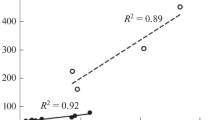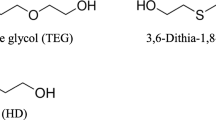Abstract
Effect of the chemical structure of urethane-containing elastomers on their abrasion resistance is studied. Dependence of the degree of volumetric wear on the hard segment content for the studied elastomers has a well-defined maximum. It is shown that polyurethanes and polyurethane ureas with a certain optimum content of hard segments exhibit the best abrasion resistance; this content depends on the chemical nature of oligomers used in synthesis.




Similar content being viewed by others
REFERENCES
C. Prisacariu, Polyurethane Elastomers: From Morphology to Mechanical Aspects (Springer Science and Business Media, 2011).
M. F. Sonnenschein, Polyurethanes: Science, Technology, Markets, and Trends (John Wiley, 2014).
F. Hakami, A. Pramanik, A. K. Basak, and N. Ridgway, “Elastomers’ wear: Comparison of theory with experiment,” Tribol. Int. 135, 46–54 (2019).
N. K. Myshkin and M. I. Petrokovets, Friction, Lubrication, Wear. Physical Foundations and Technical Applications of Tribology (Fizmatlit, Moscow, 2007) [in Russian].
V. L. Popov, Contact Interaction Mechanics and Friction Physics. From Nanotrybology to Earthquake Dynamics (Fizmatlit, Moscow, 2013) [in Russian].
K. Kwiatkowski and M. Nachman, “The abrasive wear resistance of the segmented linear polyurethane elastomers based on a variety of polyols as soft segments,” Polymers 9, 705 (2017).
V. N. Anisimov, A. A. Semenets, M. P. Letunovskii, and V. V. Strakhov, “Effect of rigid blocks on the mechanical characteristics and abrasive resistance of polyurethanes,” Mater. Sci. 38, 95–98 (2002).
Z. S. Petrović and J. Ferguson, “Polyurethane elastomers,” Prog. Polym. Sci. 16, 695–836 (1991).
Funding
The work was performed within the framework of State Assignment (the state registration number 122011900165-2) and the project “Chemical Products in Subsoil Resources Management” of the Perm Research and Education Center using the equipment of the Center for Collective Use “Research of Materials and Substances,” Perm Federal Research Center, Ural Branch, Russian Academy of Sciences.
Author information
Authors and Affiliations
Corresponding author
Ethics declarations
The authors declare that they have no conflicts of interest.
Additional information
Translated by I. Dikhter
Rights and permissions
About this article
Cite this article
Senichev, V.Y., Pogoreltsev, E.V. Relationship between the Abrasion Resistance of Urethane-Containing Elastomers and Their Structure. Polym. Sci. Ser. D 16, 549–552 (2023). https://doi.org/10.1134/S1995421223030309
Received:
Revised:
Accepted:
Published:
Issue Date:
DOI: https://doi.org/10.1134/S1995421223030309




